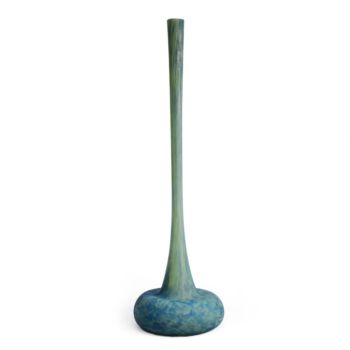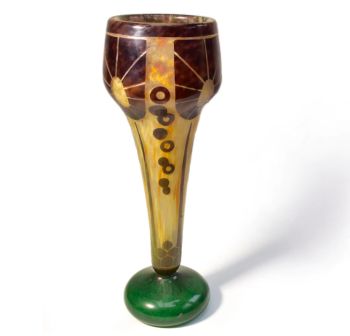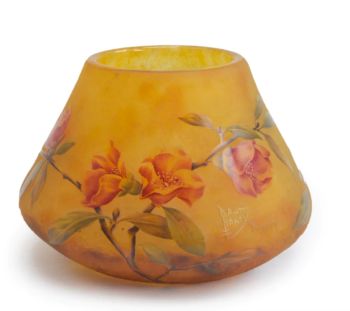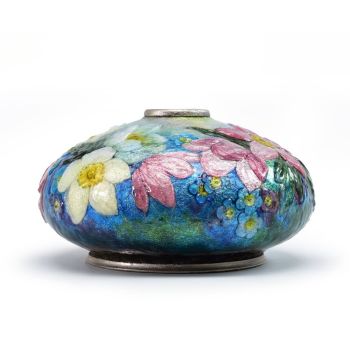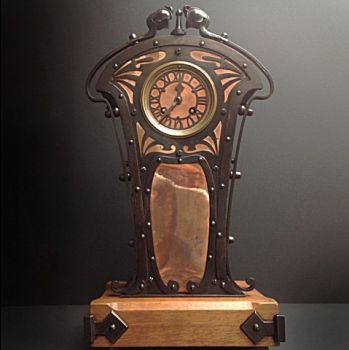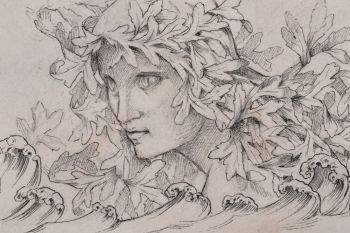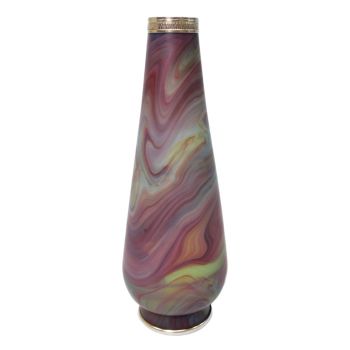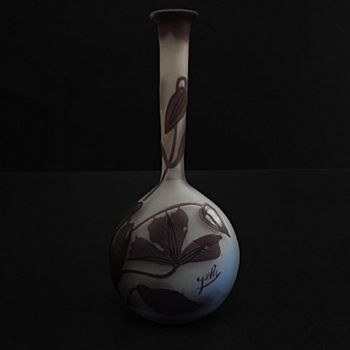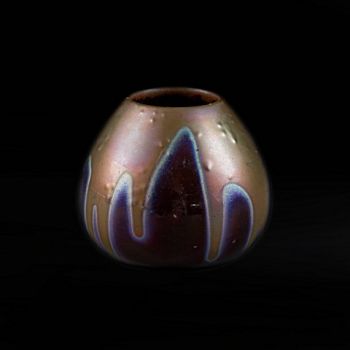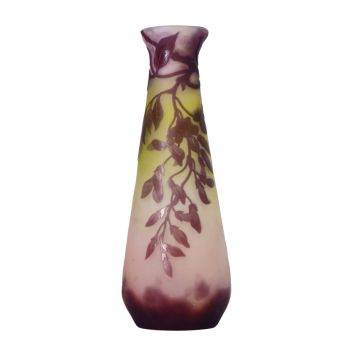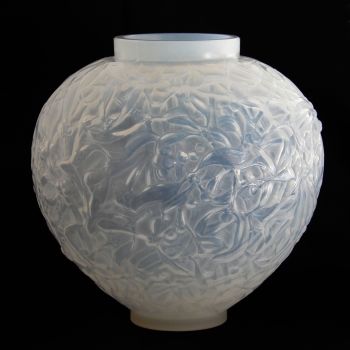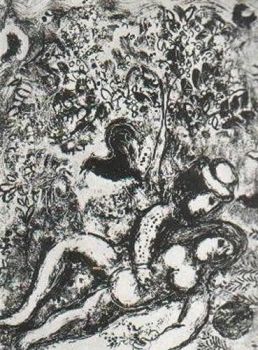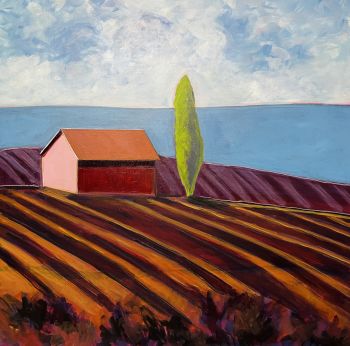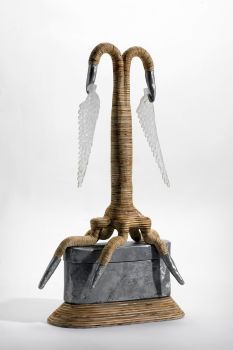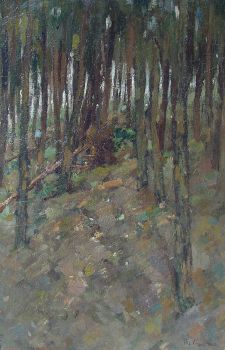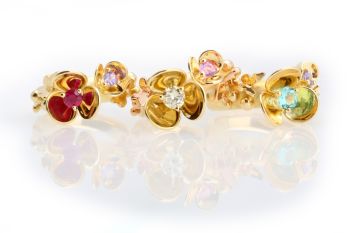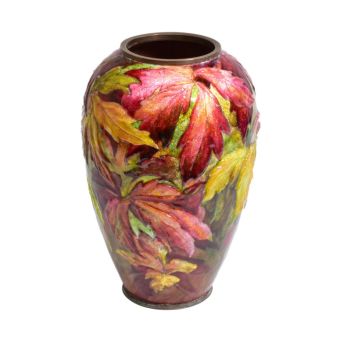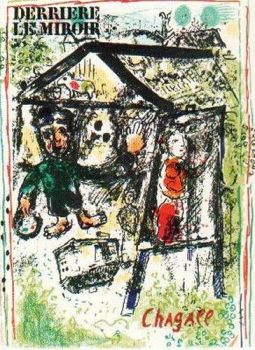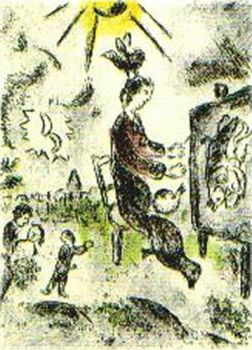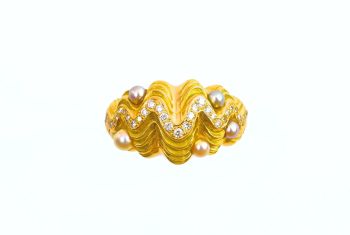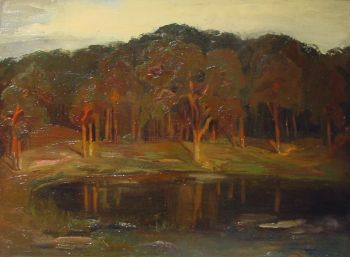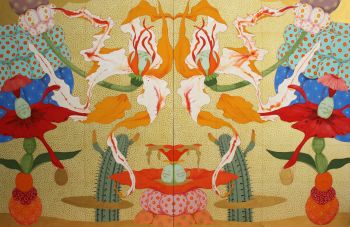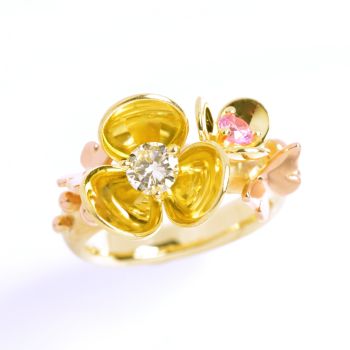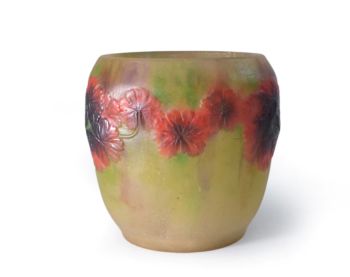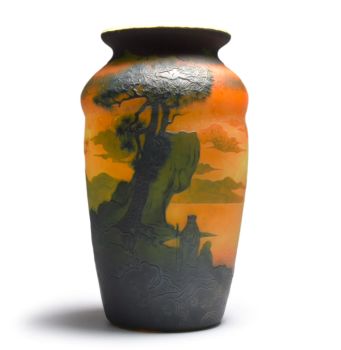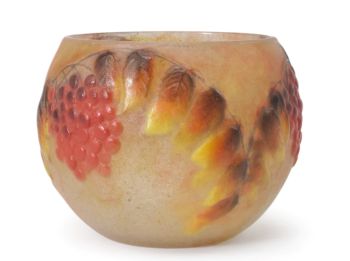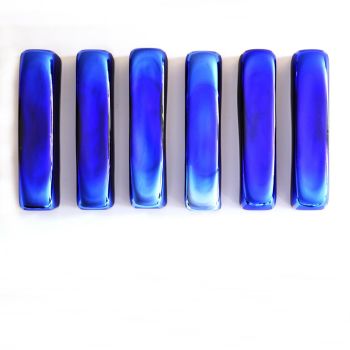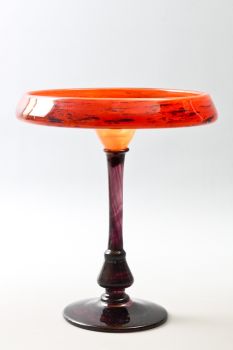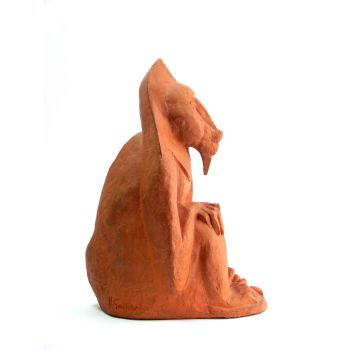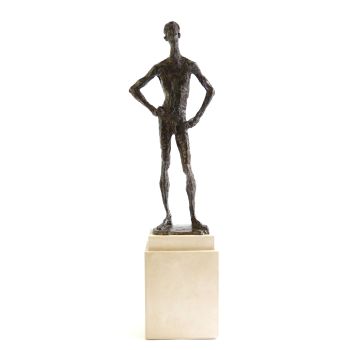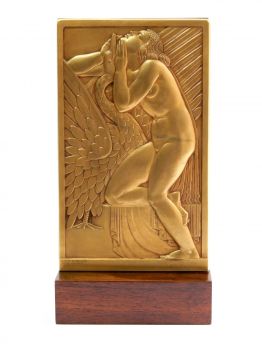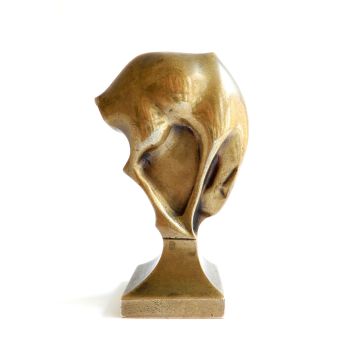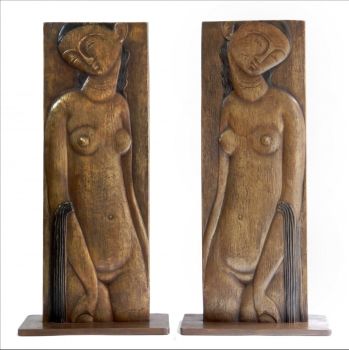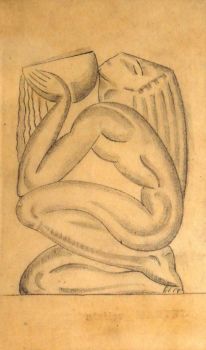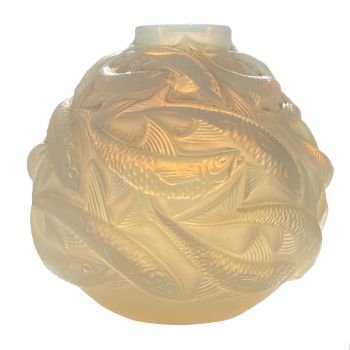Art Nouveau relief with twigs and berries 1900 - 1920
Amalric Walter
Pâte de VerreGlas
20 ⨯ 18 ⨯ 3 cm
ConditionNear mint
Preis auf Anfrage
Dille Art
- Über KunstwerkThis relief, featuring delicate twigs and berries, stands as an exceptional and rare piece by Amalric Walter. Providing insight into the artist's creative journey, Walter, originally trained as a ceramicist in Sèvres, quickly garnered recognition as a skilled glass artist.
His fascination with glass, particularly his experimentation with the rediscovered pâte de verre, led Antonin Daum to invite him to Nancy in the early 1900s to further refine the technique. Walter was granted his own workshop and furnace, initiating his pursuit of crafting exquisite vases, vide-poches, and figurines, a venture that ultimately propelled him to international fame alongside Henri Bergé, the designer behind his creations.
This specific relief signifies a rare window into the early stages of Walter's artistic evolution. Employing a meticulous process, he fashioned a mould and intricately arranged twigs and berries within it using pâte de verre, even partially translucent, with a crystal-like appearance and marbled hues.
The intricacy of this undertaking is highlighted by the uneven form and varied thicknesses. Nevertheless, the charm of the piece lies in the clear visibility of each twig, berry, and leaf.
Walter's artistic finesse is further accentuated by his thoughtful touches, such as painting the berries with red enamel and selectively adding a subtle shine to the twigs.
The result is a unique relief inspired by nature with distinct Art Nouveau influences. The relief is signed with his characteristic signature 'A. Walter, Nancy.'
The condition is excellent; there are irregularities in the glass due to the mould, such as numerous small air bubbles at the back, which is entirely normal for the manufacturing process. However, there are no damages such as chips, polishing, cracks, or any other issues. One of the photos shows the back with light shining through, providing a beautiful view of the glass. It measures 18.5 x 20 cm
Biography:
Amalric Walter (France, 1870-1959) was a very good glassmaker who was originally trained as a ceramist in Sèvres. He was already experimenting with pâte de verre when Antonin Daum persuaded him to join Daum to further develop the making of vases and figures in the difficult, newly rediscovered pâte de verre. Which he did, with great success. The beginning however was difficult, he got his own room and oven at Daum for his experiments. His first success were the Tanagra dancers, very popular at the time. They were still monotonous in colour, often light browns.
Later he worked closely with Daum's chief designer Henri Bergé (1868-1936). He also taught applied arts at the École professionnelle de l'Est.
Bergé designed all kinds of small utensils for Walter, often in a colourful palette. They became good friends.
From 1919 to 1935 Walter worked as a self-employed person and started his own studio. He then continued to collaborate with Henri Bergé, he also collaborated with various other artists.
Bergé died in 1936, which had a major influence on Amalric Walter, he himself was already visually impaired, in 1953 he was even completely blind.
Walter is best known for his animal figures made of glass paste, but also for his vide poches, inkwells, boxes and paperweights, often decorated with all kinds of animals such as butterflies, insects, lizards and flowers. Also very known are his various pendants, these were often worn with a silk cord by the most modern ladies from the better circles in the 1920's.
Besides Henry Bergé Walter also worked with other artists.
Amalric Walter did not have a high production, each design was made in small editions, partly because of this his work is sought after and can be found in various private and museum collections.
Literature:
- François le Tacon & Jean Hurstel; 'Amalric Walter, Maître de la pâte de verre', Edition Serpenoise, Metz Cedex.
- Philippe Olland; 'Dictionnaire des Maîtres Verriers de l'Art Nouveau á l'Art Déco Marques & signatures, Éditions Faton 2016. P.326-331.
- Victor Arwas, 'Glass, Art Nouveau to Art Deco', Academy Editions London 1987. P. 353-359.
- 'What is art nouveau & art deco waard', part I&II, editors Rob Zeegers Janny Stuurman-Aalbers and Reinold Stuurman, Publisher Scriptum Art , Schiedam, NL and Snoeck-Ducaju & Zoon, Ghent, Belgium, 2001. Part II, p . 110, 229, 322. - Über Künstler
Amalric Walter (Frankreich, 1870-1959) war ein sehr guter Glasmacher, der ursprünglich in Sèvre als Keramiker ausgebildet wurde. Daum überredete ihn, mit ihnen zu arbeiten und die Herstellung von Vasen und Figuren in der schwierigen, neu entdeckten Pâte de noche , die er mit großem Erfolg und vor allem in Zusammenarbeit mit Henri Bergé realisiert hat.
Von 1919 bis 1935 arbeitete Walter als Selbständiger und gründete sein eigenes Atelier. Er arbeitete auch noch viel mit Henri Bergé zusammen, arbeitete aber auch mit mehreren anderen Künstlern zusammen.
Walter ist vor allem für seine Tierfiguren aus Glaspaste bekannt, aber auch für kleinere Utensilien wie diese Vide Poche hat er auch verschiedene Anhänger hergestellt, die von den modernsten Damen aus den besseren Kreisen der 1920er Jahre oft mit einer Seidenkordel getragen wurden.
Amalric Walter hatte keine hohe Produktion, jeder Entwurf wurde in kleinen Auflagen hergestellt, auch deshalb sind seine Arbeiten begehrt und befinden sich in verschiedenen Privat- und Museumssammlungen.
Sind Sie daran interessiert, dieses Kunstwerk zu kaufen?
Artwork details
Related artworks
Amalric Walter
Amalric Walter & Henri Bergé – Crabe plumier1920 - 1929
Preis auf AnfrageAntiques Emporium
1 - 1 / 1- 1 - 4 / 24
Johann Loetz (Lötz) Witwe Klostermühle
Johann Loetz Witwe – Ausfuehrung 146 Titania vase – 19121910 - 1919
Preis auf AnfrageAntiques Emporium
Amalric Walter
Amalric Walter & Henri Bergé – Crabe plumier1920 - 1929
Preis auf AnfrageAntiques Emporium
Johann Loetz (Lötz) Witwe Klostermühle
Johann Loetz Witwe - Phänomen Genre 7773 – Orange1900 - 1910
Preis auf AnfrageAntiques Emporium
Demetre Chiparus
Demetre H. Chiparus – Bronze Art Deco statue “Rapture” – Édition Etling, Paris1920 - 1929
Preis auf AnfrageAntiques Emporium
1 - 4 / 24Jean-François Rauzier
Avatar Ttrees - Limited edition of 8 2017
Preis auf AnfrageVilla del Arte Galleries
1 - 4 / 24Amalric Walter
Amalric Walter & Henri Bergé – Crabe plumier1920 - 1929
Preis auf AnfrageAntiques Emporium
Gabriel Argy-Rousseau
Gabriël Argy-Rousseau – Crabes et Algues vase – 19201920 - 1929
Preis auf AnfrageAntiques Emporium
Unbekannter Künstler
Geflügelter venezianischer Kelch1650 - 1700
Preis auf AnfragePeter Korf de Gidts - Antiquairs
Gyrinus
Punktiertes graviertes Glas mit Putten1764 - 1766
Preis auf AnfragePeter Korf de Gidts - Antiquairs
Johann Loetz (Lötz) Witwe Klostermühle
Johann Loetz Witwe – Jugendstil Cobalt Papillon vaas1900 - 1910
Preis auf AnfrageAntiques Emporium
1 - 4 / 24- 1 - 4 / 12








